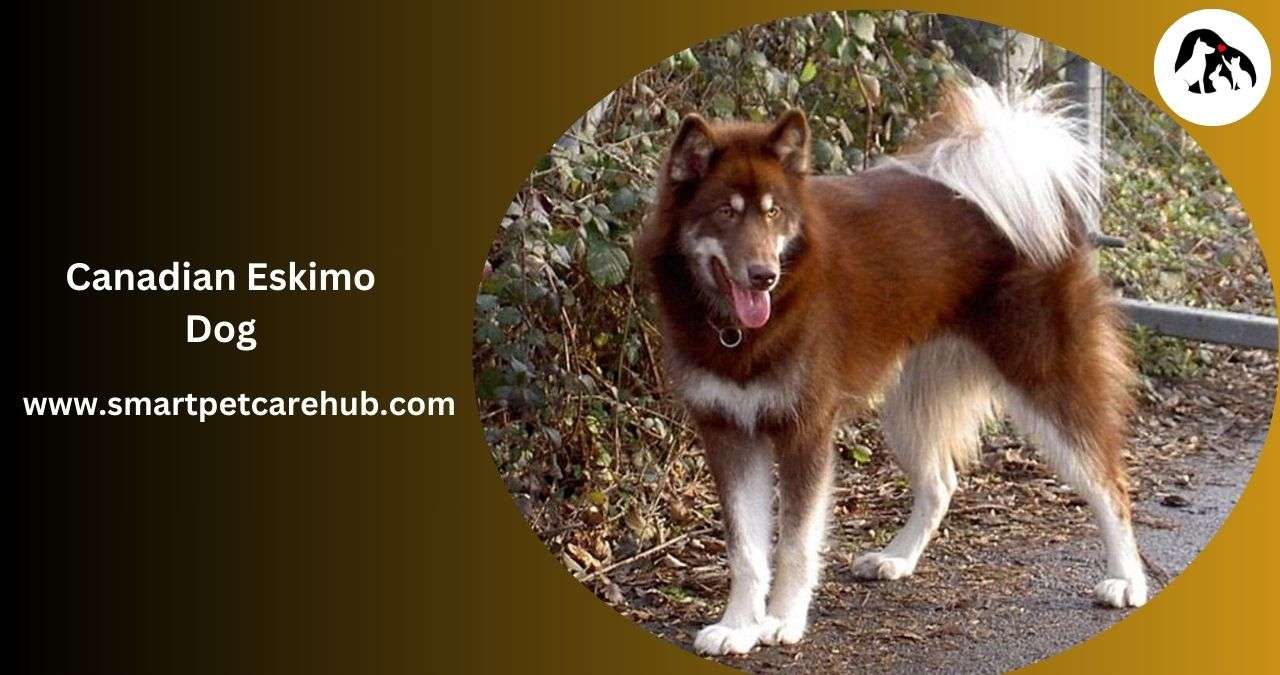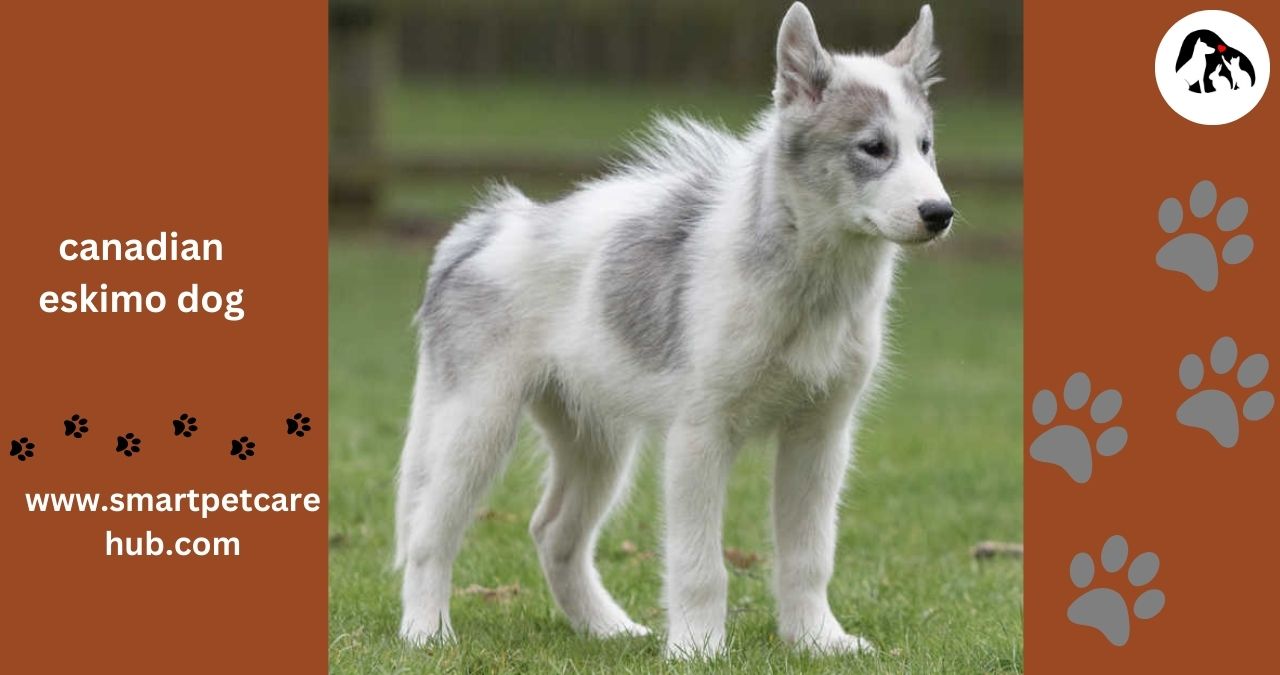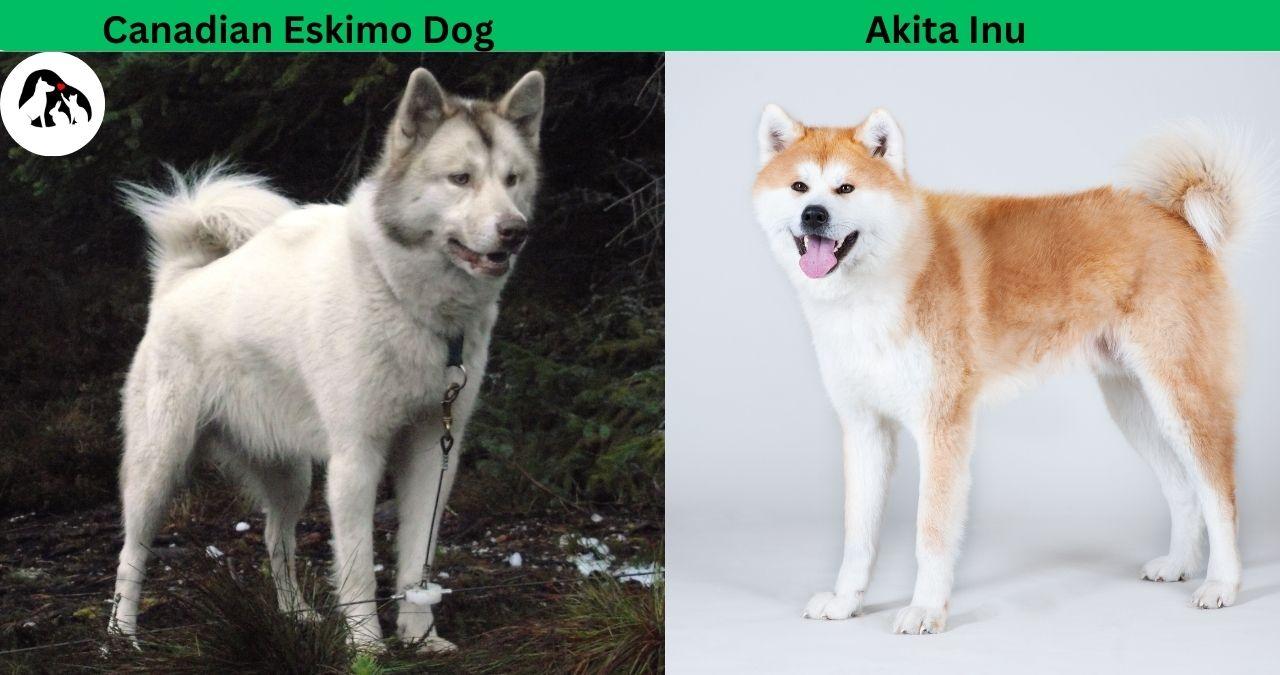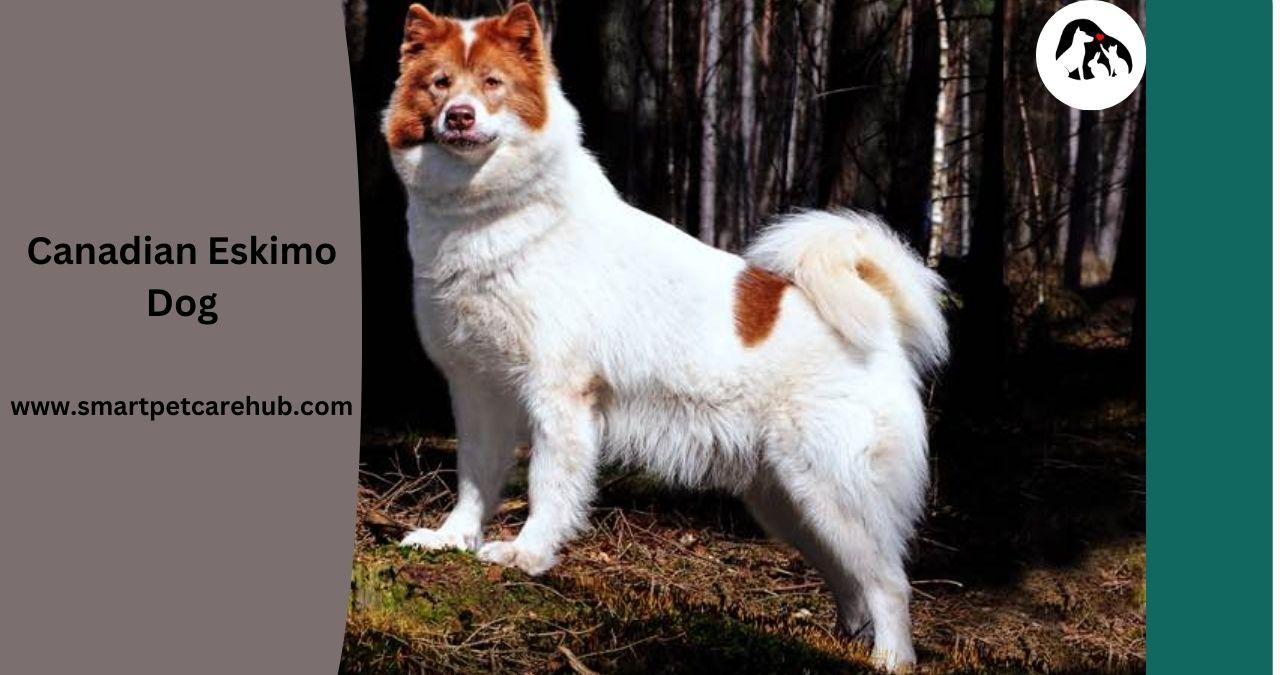Identification of the Canadian Eskimo Dog
Canadian Eskimo Dog One of the oldest breeds of the Arctic, the Canadian Eskimo Dog is known for its strength, stamina, and attractive appearance. Below is a detailed description of its physical characteristics.
Size : Canadian Eskimo Dogs are medium to large-sized dogs, with males standing 58–70 cm (23–28 inches) at the shoulder and females 50–60 cm (20–24 inches). Males typically weigh 30–40 kg (66–88 lbs), while females weigh 18–30 kg (40–66 lbs). Their muscular build reflects their heritage of working as sled dogs in the harsh conditions of the Arctic.
Color : This breed comes in a variety of colors, including white, red, gray, black, sable, and fawn, often with attractive markings or patches on the body and face. These color variations enhance their visual appeal and help them blend into the Arctic landscape to survive.
Coat : The Canadian Eskimo Dog has a thick double coat that is designed to withstand cold temperatures. The outer coat is coarse and straight, while the dense undercoat is soft and insulating. This coat sheds heavily especially during seasonal changes and requires regular maintenance.
Eyes : This breed has almond-shaped eyes that are usually dark brown or amber in color. Their eyes indicate intelligence, alertness, and their independent nature. In some cases, their eyes may appear slightly slanted, which enhances their wolf-like appearance.
Head : The Canadian Eskimo Dog has a broad, wedge-shaped head with a well-defined stop. Their head structure is strong and proportionate to their body, giving them a balanced and powerful appearance.
Ears : Their ears are medium-sized, triangular, and erect, set high on the head. These ears are well-haired to protect them from frostbite in extreme cold. The upright position also contributes to their acute hearing, which is essential for working in the Arctic.
Mouth : This dog breed has a jaw that is as strong as a scissor. Their teeth are well developed, reflecting their history of sled pulling and hunting. The structure of their mouth is practical for holding and carrying objects as well as chewing tough food.
Legs : Canadian Eskimo dogs have strong, well-muscled legs that are straight and sturdy. Their legs are designed for endurance, allowing them to pull heavy sleds long distances across snowy terrain. The front legs and hind legs are perfectly aligned, reflecting their working dog heritage.
Tail : The tail is bushy and hangs over the back in a slight curvature. This tail serves as additional insulation, as the dog often uses its tail to protect its nose and face from the cold when resting in the snow.
Paws : Their large, well-padded paws are designed to distribute weight evenly on snow and ice. The pads are tough and covered with fur to provide protection and traction from freezing temperatures. These characteristics allow them to perform effectively in arctic conditions.
The Canadian Eskimo Dog’s physical characteristics are perfectly suited for its role as a hardworking, resilient breed in one of the harshest environments on earth. This unique combination of beauty, strength, and functionality makes them a truly remarkable breed.
bite force : The bite force of the Canadian Eskimo Dog is estimated to be around 235 to 320 PSI (pounds per square inch).
average speed : The average speed of the Canadian Eskimo Dog when running at full speed is about 15 to 20 miles per hour (24 to 32 kilometers per hour).
average life : The average lifespan of the Canadian Eskimo Dog is typically 10 to 15 years.

Birth place of the Canadian Eskimo Dog
The Canadian Eskimo Dog originated in the Arctic regions of Canada, specifically in areas inhabited by the Inuit people, such as.
Nunavut
Northwest Territories
Northern Quebec (Nunavik)
Labrador
This ancient breed has been integral to the survival of indigenous Arctic communities for thousands of years, serving as sled dogs, hunting companions, and protectors.
Other name of the Canadian Eskimo Dog
The Canadian Eskimo Dog is also known by the following names.
Qimmiq (the name for “dog” in Inuit)
Canadian Inuit Dog
Inuit Sled Dog
These names reflect the breed’s historical and cultural significance to the Inuit people, as well as its primary role as a sled dog in Arctic regions.
Exercise of the Canadian Eskimo Dog
The Canadian Eskimo Dog is a highly active and energetic breed that requires regular physical and mental stimulation. Their exercise needs are vital to their health and are tied to their historical role as sled dogs.
Daily Physical Activity : The Canadian Eskimo Dog requires at least 1.5 to 2 hours of rigorous exercise per day. Activities such as long walks, runs, or hikes are ideal for satisfying their high energy levels. Without adequate exercise, they can become restless and display destructive behaviors.
Strength and Endurance Training : Given their heritage of sled pulling, these dogs benefit from activities that build strength and endurance. Weight pulling or recreational sledding can replicate their traditional work, providing both physical and mental stimulation.
Mental Stimulation : Exercise alone is not enough; they also need mental engagement. Puzzle toys, obedience training, or activities that challenge their intelligence can keep their minds sharp and prevent boredom.
Off-leash opportunities : These dogs love the freedom to run and explore. It is recommended to allow them to spend time off-leash in a secure, fenced area so they can expend their energy naturally. This also gives them a chance to enjoy their natural instinct to roam.
Social activities : Canadian Eskimo dogs thrive on social interactions. Activities such as dog sports or group training sessions can provide physical exercise, as well as improve their socialization skills with other dogs and people.
Cold-weather adventures : This breed does better in cold weather and loves outdoor activities in snowy environments. Hiking, snowshoeing, or sledding in the winter are perfect ways to keep them active and happy in their element.
Running companions : For active owners, these dogs make great running or jogging companions. Their stamina allows them to keep up with long-distance runs, making them ideal for athletic individuals.
Agility Training : Agility courses provide a fun and engaging way to exercise both the body and mind of a Canadian Eskimo Dog. These activities also strengthen the bond between the dog and its owner through teamwork.
Consistency and Routine : It is important to establish a regular exercise routine. This breed thrives on a consistent schedule, ensuring they get enough physical activity to positively channel their energy.
Avoiding Overheating : While exercise is important, care must be taken to avoid overdosing in hot weather. Their thick coats make them prone to overheating, so outdoor activities should be limited to the cooler parts of the day or cold weather.

Grooming of the Canadian Eskimo Dog
The Canadian Eskimo Dog is a robust breed designed for arctic conditions. Regular grooming helps maintain their health, hygiene, and overall well-being. Below are detailed grooming practices for this breed.
Ear Cleaning : The Canadian Eskimo Dog has upright and well-furred ears that need regular checking and cleaning to prevent infection. Use a moist cotton pad or dog-safe ear cleaner to gently remove dirt and wax buildup. Check for redness, odor, or signs of infection, especially after outdoor activities in snow or water.
Eye Care : Their almond-shaped eyes are susceptible to debris getting lodged in them, especially in dusty or snowy environments. Gently wipe their eyes with a soft, damp cloth or sterile eye wipe to remove secretions. Monitor for redness, blurriness, or irritation, as these may be signs of underlying health issues.
Dental Hygiene : Dental care is important for the Canadian Eskimo Dog as they have strong jaws and a tendency to chew on hard objects. Brush their teeth with special toothpaste for dogs and a soft-bristled toothbrush 2-3 times a week. Dental chews can supplement brushing and help reduce plaque buildup.
Skin Checks : Despite their thick double coat, regular skin checks are a must. Check for rashes, parasites, or injuries, especially after outdoor adventures. Their dense undercoat can sometimes hide problems, so separate the fur and check their skin thoroughly during grooming sessions.
Tail Care : The Canadian Eskimo Dog’s bushy tail is often curled over their back, making it a haven for debris and dirt. Brush the tail regularly to remove tangles and dirt, ensuring the fur stays clean and healthy. Check the base of the tail for any signs of irritation or entanglement.
Nail Trimming and Paw Care : Their large, well-padded paws require frequent attention, as they are important for walking on icy or rough terrain. Trim their nails every 3-4 weeks to prevent overgrowth and splitting. Inspect for cracks, cuts, or debris on the paw pads and moisturize the pads with a dog-safe balm if they appear dry.
Anal Gland Expression : Like all breeds, the Canadian Eskimo Dog may occasionally require anal gland care. If they show signs of discomfort, such as scooting or excessive licking, consult a veterinarian for gland expression. Regular grooming visits can prevent buildup and discomfort in this sensitive area.
Genital Area Cleaning : Maintaining cleanliness in the genital area is essential to prevent infection or irritation. Use a soft, damp cloth to gently clean the area, especially after outdoor excursions. For female dogs, pay extra attention during their heat cycles, and for males, make sure the sheath area stays clean.
Brushing and Coat Care : While not part of the requested sections, brushing their dense double coat is important for overall grooming. Use an undercoat rake to remove loose fur and prevent matting, especially during seasonal shedding. Regular brushing keeps the skin healthy and free of parasites.
Bathing : While the Canadian Eskimo Dog does not require frequent bathing, an occasional bath with a gentle, dog-specific shampoo will help maintain the health of their coat and skin. Avoid over-bathing, as this can strip out the natural oils in their coat. Rinse thoroughly to ensure no residue is left in their dense fur.
Proper grooming ensures that the Canadian Eskimo Dog stays comfortable, healthy, and ready for their active lifestyle. Regular care helps prevent health problems and strengthens the bond between dog and owner.
Common Health Problems of the Canadian Eskimo Dog
The Canadian Eskimo Dog is a strong and sturdy breed, known for its resilience in the harsh Arctic environment. However, like all breeds, they are prone to certain health problems that can affect their quality of life. Understanding these conditions allows for early identification and better management. Here are some common health issues.
Hip Dysplasia : Hip dysplasia is a common condition in large breeds, where the hip joint does not fit properly into the hip socket, leading to arthritis and pain. Symptoms include difficulty getting up, limping, stiffness and reluctance to jump or exercise. It is managed with regular vet checks, pain-relieving medications, physiotherapy or surgery in severe cases. Maintaining a healthy weight is important to reduce stress on the joints.
Elbow Dysplasia : Similar to hip dysplasia, this condition affects the elbow joint, where the bones do not develop properly, causing pain and limited movement. Symptoms include lameness in the front legs, difficulty walking and swelling in the elbow area. Management of this may require surgery, along with anti-inflammatory medications and joint supplements to alleviate symptoms.
Arthritis : This is a degenerative condition often associated with aging dogs, causing joint swelling and pain. Stiffness, difficulty walking, reluctance to exercise, and limping. Weight management, pain medications, joint supplements such as glucosamine, and gentle exercise can help improve mobility.
Bloat (gastric dilatation and volvulus) : Bloat occurs when the stomach fills with gas and can twist, causing a life-threatening condition. Abdominal swelling, discomfort, drooling, excessive panting, and rapid breathing are common. Prompt veterinary care is important. Preventive measures include feeding small meals throughout the day and limiting exercise immediately after eating.
Eye problems : Canadian Eskimo dogs can suffer from a variety of eye problems, including cataracts and progressive retinal atrophy (PRA), which can lead to vision loss. Blurred eyes, difficulty seeing in low light, and noticeable changes in behavior such as bumping into objects. Cataracts may require surgical intervention, while PRA is managed with regular veterinary checkups and adapting the dog’s environment to their visual limitations.
Hypothyroidism: Hypothyroidism is a condition where the thyroid gland does not produce enough hormones, affecting metabolism. Causing weight gain, lethargy, hair loss, dry skin, and intolerance to cold. Lifelong thyroid hormone replacement therapy with regular blood tests to monitor hormone levels.
Cold-related injuries: Despite being an arctic breed, extreme cold can still cause frostbite or hypothermia, especially if the dog is not accustomed to harsh weather conditions. Symptoms include shivering, lethargy, pale or blue skin, and frostbite on ears, paws, or tail.
Provide adequate shelter, proper winter gear, and limit exposure to extreme cold during walks or outdoor activities.
Parasitic Infections : Like many dogs, the Canadian Eskimo Dog can be susceptible to fleas, ticks and intestinal parasites. This can cause itching, redness, hair loss, digestive problems or unusual lethargy. Regular flea and tick prevention, deworming and regular vet checks are recommended to detect and treat parasitic infections.
Skin Problems : The Canadian Eskimo Dog can suffer from various skin conditions including allergies, dermatitis and hot spots. These can be triggered by environmental factors or food allergies. This can cause itching, redness, hair loss and flaking. Regular grooming, hypoallergenic diets and topical treatments can help manage skin conditions. Severe cases may require allergy testing and medication.
Obesity : Obesity is a growing problem in many dog breeds, including the Canadian Eskimo Dog, especially if they are not exercised enough or are fed an improper diet. They can become obese. and excess weight, difficulty walking and reduced activity levels. Proper portion control, a balanced diet and regular exercise are essential to prevent obesity and its associated health problems, such as joint strain and heart disease.

Popular Canadian Eskimo Dog Mixed Breeds
Canadian Husky (Canadian Eskimo Dog x Siberian Husky) : This mix blends the stamina of the Canadian Eskimo Dog and the athleticism of the Siberian Husky. Known for their charming appearance and lively personality, Canadian Huskies are ideal for active owners who enjoy outdoor activities. Their dense double coat requires regular grooming, and they thrive in cold weather. These dogs are friendly but can also be independent, which requires consistent training and mental stimulation.
Eskimo Malamute (Canadian Eskimo Dog x Alaskan Malamute) : The Eskimo Malamute is a powerful mix, with strength and resilience. This breed excels at activities like sledding and hiking, making them the perfect companion for adventurous individuals. They have a thick, weather-resistant coat and a calm but independent temperament. Socialization and training from an early age are key to managing their strong-willed nature.
Canadian Lab (Canadian Eskimo Dog x Labrador Retriever) : This mix combines the work ethic of the Canadian Eskimo Dog with the friendly demeanor of the Labrador. Canadian Labs are energetic, playful, and great with children, making them a great family pet. Their adaptability allows them to fit well into a variety of living environments, but they do need ample exercise and mental stimulation to avoid boredom.
Canadian Shepherd (Canadian Eskimo Dog x German Shepherd) : A highly intelligent and loyal hybrid, the Canadian Shepherd is a protective yet lovable companion. These dogs can be trained and excel at tasks such as guarding and search-and-rescue missions. They inherit a strong work drive from both parent breeds and need a home that can provide structured training and plenty of exercise.
Canadian Samoyed (Canadian Eskimo Dog x Samoyed) : With the Canadian Samoyed, you get a mix of friendliness and toughness. These dogs are social, affectionate and thrive in a family environment. Their thick, furry coat is a distinctive feature that needs frequent grooming. They are active and playful, requiring daily exercise to stay happy and healthy.
Canadian Akita (Canadian Eskimo Dog x Akita Inu) : The Canadian Akita is a mix of strength and loyalty. This breed is protective and makes an excellent guard dog, but they also have a calm and affectionate side. They are better suited to experienced owners who can provide firm and consistent training. Their striking appearance with a dense coat and curled tail adds to their appeal.
Canadian Pyrenees (Canadian Eskimo Dog x Great Pyrenees) : A gentle giant, the Canadian Pyrenees combines the stamina of the Canadian Eskimo Dog with the protection instincts of the Great Pyrenees. These dogs are calm and attentive, making them excellent livestock protectors. They do well in spacious environments and require moderate exercise to maintain their health.
Canadian Collie (Canadian Eskimo Dog x Border Collie) : This high-energy mix inherits intelligence and agility from the Border Collie parent. Canadian Collies are quick learners and excel at activities like agility training and herding. Their playful and friendly nature makes them great companions, but they do require an active home that can meet their exercise and mental stimulation needs.
Canadian Golden Retriever (Canadian Eskimo Dog x Golden Retriever) : This hybrid combines the friendly and affectionate personality of the Golden Retriever with the stamina of the Canadian Eskimo Dog. They are loyal, easygoing, and great with children, making them ideal family pets. Their medium to large size and adaptable temperament allow them to thrive in a variety of living situations, provided they get enough exercise.
Canadian Wolfhound (Canadian Eskimo Dog x Irish Wolfhound) : A unique and impressive mix, the Canadian Wolfhound combines the stamina of the Canadian Eskimo Dog and the gentle demeanor of the Irish Wolfhound. These dogs are ideal for experienced owners who appreciate their independent instincts and calm temperament. They are best suited for large spaces and require daily moderate exercise to stay satisfied.


Leave a Reply
You must be logged in to post a comment.